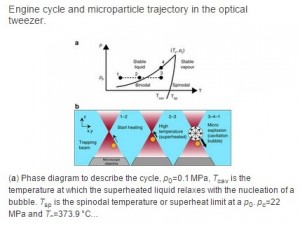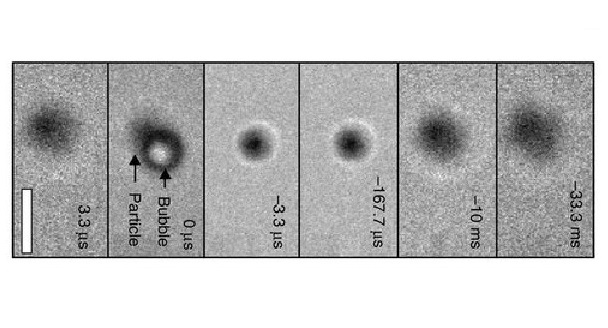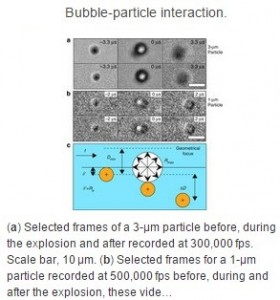How small are Dr. Pedro A. Quinto-Su’s steam engines? Smaller than red blood cells and most bacteria–between one and three millionths of a meter. The significantly strong pistons are powered by a combined process of optical manipulation which bypasses microfabrication and draws strength from simplicity, taking scientists one step closer to the “lab on a chip” miniaturization of everything.
“The piston–a microsphere–is powered by light, which also heats the sphere inducing the vapor microexplosions. Similar to an internal piston combustion engine,” Dr. Pedro Quinto-Su, physics professor at the Universidad Nacional in Mexico, told The Speaker.
“This is the first time that a steam engine has been miniaturized to a length scale of a micrometer,” Quinto-Su told us. “Also, the engine works in an environment dominated by fluctuations (Brownian), since it is immersed in liquid. In the context of optical micromanipulation the report shows that it is possible to have impulsive forces in an optical tweezer, which could extend even more the wide array of applications that use that technique.”
Quinto-Su placed the microscopic piston in historical context.
“In the past, the improved steam engine design of Watt started the industrial revolution and understanding the mechanism initiated modern thermodynamics. Steam engines were the foundation for all the engines that we have today.
“Now steam engines are mainly used for energy conversion in power plants, where steam turbines convert mechanical energy into electricity.”
There has been much interest in miniaturizing heat engines, Quinto-Su explained.
“In the last few decades there has been a trend in trying to miniaturize everything. In science this concept has been called “lab on a chip” and the idea is to have everything that is needed to make an experiment in a small chip. The interest in miniaturized versions of heat engines is that they could be used to do work in very localized volumes. For example, periodically displacing small objects including nanomaterials.”
Quinto-Su explained the challenges to miniaturization past the 1mm scale–the lower limit until the recent invention–and how his steam engine bypassed the previous obstacles.
“The main problem with tiny heat engines is that the efficiency is very poor. A few heat engines have been demonstrated at the micrometer scale with different working mechanisms. However, traditional heat engines that work with the expansion and compression of gas had not reached scales below 1mm, perhaps because most designs involved the assembly of microfabricated moving parts which made it more challenging–in addition to the expected poor efficiency.
“The implementation of the reported micrometer-sized piston steam engine is very simple and there is no need for microfabrication, only optical access is required. It needs an optical tweezer setup which is a widely available tool.”
Quinto-Su explained how the project began–as an attempt to combine two methods of microscopic manipulation to create the micro-piston.
“The project started by trying to combine two techniques of optical manipulation of microscopic objects immersed in liquids: optical tweezers and microscopic explosions (cavitation bubbles).”
Quinto-Su explained how small the steam engines were, and put in layman’s’ terms how the various elements of the engines work.
“In the reported engine a spherical microparticle (1 or 3 micrometers in diameter, the largest dimension of a human red blood cell is about 10 micrometers) is periodically displaced by light and microscopic explosions.
“Optical tweezers use a focused laser beam that attracts transparent microscopic objects towards the focused spot. The objects are usually immersed in liquid and they are called colloids, usually these objects are microscopic spheres. Once the microparticles reach the focus of the laser beam they stay trapped in there. This technique exerts very small controlled forces (pico Newtons) in the microscopic objects.
“In contrast, microscopic vapor explosions in liquids exert large impulsive forces in the vicinity where the explosions are created. A vapor explosion creates a rapidly expanding bubble that later collapses (cavitation bubble). The bubble displaces the liquid at a very fast speed which also displaces the objects in the vicinity, exerting impulsive forces several orders of magnitude larger than those of optical tweezers.
“In the reported work, a spherical microparticle that is not completely transparent to the laser beam is placed in an optical tweezer. In this  way the sphere is attracted towards the focus of the beam, but at the same time it is heated because it is not transparent to the light. Once the sphere is close to the focus it is heated at a very fast rate and the liquid in contact with the microsphere explodes, pushing the sphere close to the starting position. Then the light forces take over and start attracting the sphere towards the focus repeating the cycle.
way the sphere is attracted towards the focus of the beam, but at the same time it is heated because it is not transparent to the light. Once the sphere is close to the focus it is heated at a very fast rate and the liquid in contact with the microsphere explodes, pushing the sphere close to the starting position. Then the light forces take over and start attracting the sphere towards the focus repeating the cycle.
“Hence the combination of optical tweezers and vapor explosions resulted in a microparticle (piston) that is periodically attracted towards the focused laser and then is pushed away at a fast speed by microscopic vapor explosions. In a sense it is similar to an internal piston combustion engine.”
Quinto-Su noted that the the microexplosions are not initiated by a spark, but by a sudden temperature increase, similar to a diesel engine.
The power created by the pistons is significant, Quinto-Su explained.
“The average power is about 0.3 pico Watts and the power density is about two orders of magnitude less than that typical of car engines. However the effects at the microscopic scale are significant and could be used to pump small volumes of liquid or exert impulsive forces in nearby objects.”
The micro-pistons can be compared with the effect of transducers when driven at acoustic and ultrasound frequencies.
“Because transducers can be used to induce oscillations in liquid-gas boundaries which produce flow. In this case, the operation of the engine is periodic displacements of the piston and periodic explosions which also produce flow, similar to the effect of transducers.”
The report, “A microscopic steam engine implemented in an optical tweezer,” was authored by Pedro A. Quinto-Su and was published in Nature Communications
Three videos from Dr Pedro A. Quinto-Su’s research – 1-3 μm particle engines.
[su_youtube url=”https://www.youtube.com/watch?v=CovgaA20Mmc&list=PLkY-3tl_jYeCgAXAOU74h3p1uoxba7ofc”][su_video url=”http://physics.aps.org/assets/0306a6a4-533e-4249-afbf-b6e49aaa6004/video-v1.mp4″ loop=”yes”][/su_youtube]
[su_youtube url=”https://www.youtube.com/watch?v=T6gRqpHU4iY&index=2&list=PLkY-3tl_jYeCgAXAOU74h3p1uoxba7ofc”][su_video url=”http://physics.aps.org/assets/0306a6a4-533e-4249-afbf-b6e49aaa6004/video-v1.mp4″ loop=”yes”][/su_youtube]
[su_youtube url=”https://www.youtube.com/watch?v=TisxDL5dP_g&index=3&list=PLkY-3tl_jYeCgAXAOU74h3p1uoxba7ofc”][su_video url=”http://physics.aps.org/assets/0306a6a4-533e-4249-afbf-b6e49aaa6004/video-v1.mp4″ loop=”yes”][/su_youtube]

